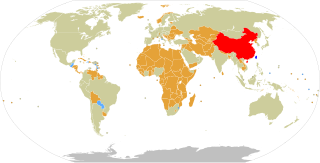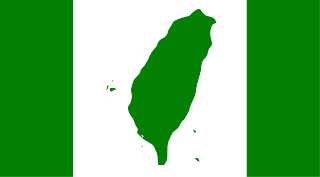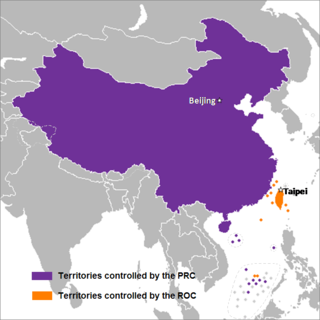Related Research Articles

Taiwan, currently has formal diplomatic relations with 12 of the 193 United Nations member states and with the Holy See, which governs Vatican City, as of 11 August 2023. In addition to these relations, the ROC also maintains unofficial relations with 59 UN member states, one self-declared state (Somaliland), three territories, and the European Union via its representative offices and consulates under the One China principle. The Government of the Republic of China has the 31st largest diplomatic network in the world with 110 offices.

The Taiwan independence movement is a political movement which advocates the formal declaration of an independent and sovereign Taiwanese state, as opposed to Chinese unification or the status quo in Cross-Strait relations.

The member states of the United Nations comprise 193 sovereign states. The United Nations (UN) is the world's largest intergovernmental organization. All members have equal representation in the UN General Assembly.
The controversy surrounding the political status of Taiwan or the Taiwan issue is a result of World War II, the second phase of the Chinese Civil War (1945–1949), and the Cold War.
The term One China may refer, in alphabetical order, to one of the following:
China is one of the charter members of the United Nations and is one of five permanent members of its Security Council.

The Joint Communique of the Government of Japan and the Government of the People's Republic of China was signed on September 29, 1972, in Beijing. The communique established and normalized diplomatic relations between Japan and the People's Republic of China (PRC), resulted in the severing of official relations between Japan and the Republic of China (ROC) in Taiwan. The document produced nine articles in a joint statement, showing compromises on previously ambiguous principles enunciated by both sides. Of these, four points are particularly worthy of attention:
- the desire for a peace treaty between Japan and China;
- the statement that Japan "understands and respects [China's] stance" that Taiwan is part of the PRC;
- an Asia-Pacific anti-hegemony clause;
- Japan's reversal of relations with China and Taiwan.

The United Nations General Assembly Resolution 2758 was passed in response to the United Nations General Assembly Resolution 1668 that required any change in China's representation in the UN be determined by a two-thirds vote referring to Article 18 of the UN Charter. The resolution, passed on 25 October 1971, recognized the People's Republic of China (PRC) as "the only legitimate representative of China to the United Nations" and removed "the representatives of Chiang Kai-shek" from the United Nations.

The Soviet Union was a charter member of the United Nations and one of five permanent members of the Security Council. Following the dissolution of the Soviet Union in 1991, its UN seat was transferred to the Russian Federation, the successor state of the USSR.

Since its founding in 1949, the People's Republic of China (PRC) has had a diplomatic tug-of-war with its rival in Taiwan, the Republic of China (ROC). Throughout the Cold War, both governments claimed to be the sole legitimate government of all China and allowed countries to recognize either one or the other. Until the 1970s, most Western countries in the Western Bloc recognized the ROC while the Eastern Bloc and Third World countries generally recognized the PRC. This gradually shifted and today only 12 UN member states recognize the ROC while the PRC is recognized by the United Nations, 180 UN member states and the State of Palestine as well as Cook Islands and Niue. Both the ROC and the PRC maintain the requirement of recognizing its view of the One China policy to establish or maintain diplomatic relations. The United Kingdom did recognize the PRC in 1950 but an exchange of Ambassadors was refused by the PRC until 1972.
The United Nations General Assembly Resolution 505 is titled Threats to the political independence and territorial integrity of China and to the peace of the Far East, resulting from Soviet violations of the Sino-Soviet Treaty of Friendship and Alliance of August 14, 1945 and from Soviet violations of the Charter of the United Nations. The UN General Assembly adopted this resolution on 1 February 1952 during its sixth session after the Republic of China complained to the United Nations against the Soviet Union.

The Formosa Resolution of 1955 was a joint resolution passed by the U.S. Senate and signed by U.S. President Dwight D. Eisenhower on January 29, 1955, to counteract the threat of an invasion of Taiwan by the People's Republic of China (PRC). The resolution gave the U.S. president the authority “to employ the Armed Forces of the United States as he deems necessary for the specific purpose of securing and protecting Formosa and the Pescadores against armed attack [by the Communists]”.

"Taiwan, China", "Taiwan, Province of China", and "Taipei, China" are controversial political terms that claim Taiwan and its associated territories as a province or territory of "China".
An exclusive mandate is a government's assertion of its legitimate authority over a certain territory, part of which another government controls with stable, de facto sovereignty. It is also known as a claim to sole representation or an exclusive authority claim. The concept was particularly important during the Cold War period when a number of states were divided on ideological grounds.

The term "Two Chinas" refers to the geopolitical situation where two political entities exist under the name "China".
Chapter II of the United Nations Charter deals with membership to the United Nations (UN) organization. Membership is open to the original signatories and "all other peace-loving states" that accept the terms and obligations set forth in the UN Charter and, "in the judgment of the Organization, are able and willing to carry out these obligations". According to Chapter II of the UN Charter, in order to be admitted to the UN, a country must first be recommended by the UN Security Council and then approved by a vote of the UN General Assembly. In addition, the admission must not be opposed by any of the five permanent members of the UN Security Council, sometimes referred to as the Permanent Five or P5.

The permanent members of the United Nations Security Council are the five sovereign states to whom the UN Charter of 1945 grants a permanent seat on the UN Security Council: China, France, Russia, the United Kingdom, and the United States.
The People's Socialist Republic of Albania joined the United Nations on 14 December 1955, and has participated in several UN peacekeeping operations. The current Representative of Albania in the UN is Mr. Ferit Hoxha. Albania is a non-permanent member of the 15-country UN Security Council for the two-year term (2022–2023).

On April 13, 1919, the Republic of China recognized the Provisional Government of the Republic of Korea. The Nationalist government of China participated in the Cairo Conference which resulted in the Cairo Declaration with the aim of freeing Korea and Taiwan from Japanese colonial rule. After the communist takeover of Mainland China in 1949 and the establishment of the Democratic People's Republic of Korea in 1948, relations between the two are non-existent, however, unofficial relations are significant.
The Soviet Union boycotted the United Nations from 13 January until 1 August 1950. The boycott originated over a dispute over the representation of China before the United Nations. The Soviet Union demanded the representatives of the People's Republic of China (PRC) be seated in the United Nations Security Council while the United Nations recognized representatives of the Kuomintang and the Republic of China. After the Soviet Union lost a motion to seat the PRC in the UN on 13 January 1950, it decided to boycott the organization.
References
- 1 2 3 4 Bulsara, Sanket (1995). "Out in the Cold: The Politics of Taiwan's Exclusion from the UN". Harvard International Review . 17 (3): 52–84. ISSN 0739-1854. JSTOR 42761198 – via JSTOR.
- 1 2 3 4 Torelli, Angela (2012). "The Costs of Realism: The Nixon Administration, the People's Republic of China, and the United Nations". The Journal of American-East Asian Relations . 19 (2): 157–182. doi:10.1163/18765610-01902001. ISSN 1058-3947. JSTOR 23613339 – via JSTOR.
- 1 2 3 4 Luard, Evan (1971). "China and the United Nations". International Affairs. 47 (4): 729–730. doi:10.2307/2625680. ISSN 0020-5850. JSTOR 2625680.
- ↑ Bloomfield, Lincoln P. (1966).p.655
- ↑ Torelli, Angela (2012).p158
- 1 2 3 4 "Representation of China Within the United Nations System". International Legal Materials. 11 (3): 561–570. May 1972. doi:10.1017/S0020782900035981. ISSN 0020-7829. S2CID 249005748 – via Cambridge University Press.
- ↑ Luard, Evan (1971).p.730
- 1 2 3 4 5 6 7 Bloomfield, Lincoln P. (1966). "China, the United States, and the United Nations". International Organization. 20 (4): 673. doi:10.1017/S0020818300012923. ISSN 0020-8183. JSTOR 2705735. S2CID 154917681.
- 1 2 Luard, Evan (1971)pp.731–732
- 1 2 Luard, Evan (1971)p.732
- 1 2 Bloomfield, Lincoln P. (1966). "China, the United States, and the United Nations". International Organization. 20 (4): 653–676. doi:10.1017/S0020818300012923. ISSN 0020-8183. JSTOR 2705735. S2CID 154917681.
- 1 2 Luard, Evan (1971)p.736
- ↑ Bailey, Sydney D. (1971). "China and the United Nations". The World Today. 27 (9): 365–372. ISSN 0043-9134. JSTOR 40394545.
- 1 2 3 Hickey, Dennis V. (1997). "U.S. Policy and Taiwan's Bid to Rejoin the United Nations". Asian Survey. 37 (11): 1032. doi:10.2307/2645739. ISSN 0004-4687. JSTOR 2645739.
- ↑ "Representation of China Within the United Nations System" p.562
- ↑ "Representation of China Within the United Nations System" p.567
- ↑ "Representation of China Within the United Nations System" pp.563–564
- ↑ "FAO - News Article: FAO and China mark 40 years of cooperation in hunger fight". www.fao.org. Retrieved 2023-07-17.
- ↑ "Representation of China Within the United Nations System" p.569
- ↑ "Representation of China Within the United Nations System" pp.565–566
- ↑ "Representation of China Within the United Nations System" pp.568–569
- 1 2 Bulsara, Sanket (1995).p.53